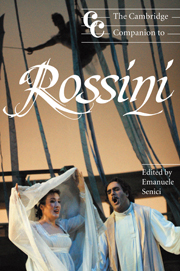14 - Staging Rossini
from Part IV - Performance
Published online by Cambridge University Press: 28 September 2011
Summary
Staging conventions and practices in Italy
The visual realisation of Rossini's operas – décors, costumes and props – was at first directly dependent on a system of theatrical production and management rooted in the last years of the ancien régime. Two staging practices coexisted in Italy: these were not strictly separate, but, on the contrary, often interrelated. Smaller theatres had a stock of about eight or ten sets, called ‘di dotazione’ (literally, ‘dowry’), which could be used for the majority of scene changes asked for in the librettos; more could be added if necessary. Major opera houses (La Scala in Milan, the San Carlo in Naples, La Fenice in Venice, the Teatro Regio in Turin and a few others) provided new sets each season only for opere serie; if opere buffe were staged, their sets were not updated quite so frequently. Statistically the ‘dotazione’ system prevailed, as can be seen from the Indice de' teatrali spettacoli published annually in Milan, from which we discover that in the year 1790 opera seasons took place in eighty different Italian cities and towns and an even larger number of theatres (some cities had more than one theatre).
The importance of productions in major opera houses which employed the most famous stage designers and offered the novelties of the season is obvious; these were the operas which, if successful, would be taken to other venues, thus supplying this massive operatic circuit. This constant need for new works was partly satisfied by the circulation of a large number of comic operas, while the serious repertoire remained much more limited.
- Type
- Chapter
- Information
- The Cambridge Companion to Rossini , pp. 204 - 215Publisher: Cambridge University PressPrint publication year: 2004
- 1
- Cited by



